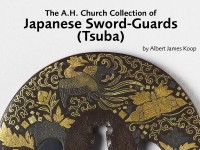The A. H. Church Collection of Japanese Sword-Guards (Tsuba)
An unpublished catalogue of the A. H. Church collection of Japanese sword-guards (tsuba) by Albert James Koop.

With the fall of the anti-Tokugawa party in 1615 and the consequent decline of Fushimi as an art-centre, the inlayers of practising there found their livelihood at an end. Many of them accepted the invitation to Mayeda Toshiiye, the powerful daimio of Kaga province, to practise their art in his service. At Kanazawa, the Kaga capital, they founded several schools (Katsuji, Tsuji, Kuninaga, Kuwamura, Midzuno, Koichi) which at first continued the Fushimi style of flat brass, silver or copper inlay on iron, later adding gold and shakudō. In later times the softer metals, such as copper and its alloys, largely replaced iron as a base; designs became freer, the work more showy and of greater delicacy. Engraving, at first confined to details of the inlaid work, now lent its aid to outlining or even supplementing it.
Other schools making a speciality of hira-zōgan are dealt with in [other chapters].
Notice
Object information may not accurately reflect the actual contents of the original publication, since our online objects contain current information held in our collections database. Click on 'buy this publication' to purchase printed versions of our online publications, where available, or contact the Jameel Study Centre to arrange access to books on our collections that are now out of print.
© 2013 University of Oxford - Ashmolean Museum






